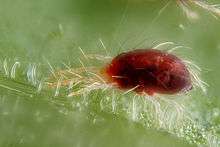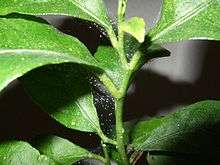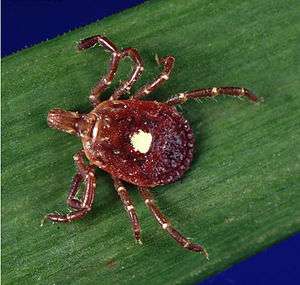Spider mite
| Spider mites | |
|---|---|
 | |
| Tetranychus urticae | |
| Scientific classification | |
| Kingdom: | Animalia |
| Phylum: | Arthropoda |
| Class: | Arachnida |
| Subclass: | Acari |
| Order: | Trombidiformes |
| Superfamily: | Tetranychoidea |
| Family: | Tetranychidae Donnadieu, 1875 |
| Subfamilies & tribes | |
|
Bryobinae Berlese
Tetranychinae Berlese
| |
Spider mites are members of the Acari (mite) family Tetranychidae, which includes about 1,200 species.[1] They generally live on the undersides of leaves of plants, where they may spin protective silk webs, and they can cause damage by puncturing the plant cells to feed.[2] Spider mites are known to feed on several hundred species of plants.
Description
Spider mites are less than 1 millimetre (0.04 in) in size and vary in color. They lay small, spherical, initially transparent eggs and many species spin silk webbing to help protect the colony from predators; they get the "spider" part of their common name from this webbing.[2]
Life cycle

Hot, dry conditions are often associated with population build-up of spider mites. Under optimal conditions (approximately 80 °F or 27 °C), the two-spotted spider mite can hatch in as little as 3 days, and become sexually mature in as little as 5 days. One female can lay up to 20 eggs per day and can live for 2 to 4 weeks, laying hundreds of eggs. This accelerated reproductive rate allows spider mite populations to adapt quickly to resist pesticides, so chemical control methods can become somewhat ineffectual when the same pesticide is used over a prolonged period.[3]
Spider mites, like hymenopterans and some scale insects, are arrhenotochous: females are diploid and males are haploid.[4] When mated, females avoid the fecundation of some eggs to produce males. Fertilized eggs produce diploid females. Unmated, unfertilized females still lay eggs, that originate exclusively haploid males.
Genera (Classification)
The best known member of the group is Tetranychus urticae, which has a cosmopolitan distribution,[5] and attacks a wide range of plants, including peppers, tomatoes, potatoes, beans, corn, cannabis, and strawberries.[3] Other species which can be important pests of commercial plants include Panonychus ulmi (fruit tree red spider mite) and Panonychus citri (citrus red mite).
The family is divided into the following subfamilies, tribes and genera:[6]
- Bryobinae Berlese
- Bryobini Reck
- Neoschizonobiella Tseng
- Sinobryobia Ma et al.
- Marainobia Meyer
- Bryobia Koch
- Toronobia Meyer
- Pseudobryobia McGregor
- Strunkobia Livshitz & Mitrofanov
- Mezranobia Athias-Henriot
- Eremobryobia Strunkova & Mitrofanov
- Bryobiella Tuttle & Baker
- Hemibryobia Tuttle & Baker
- Hystrichonychini Pritchard & Baker
- Bryocopsis Meyer
- Tetranychopsis Canestrini
- Notonychus Davis
- Dolichonobia Meyer
- Monoceronychus McGregor
- Mesobryobia Wainstein
- Hystrichonychus McGregor
- Parapetrobia Meyer & Rykev
- Peltanobia Meyer
- Tauriobia Livshitz & Mitrofanov
- Aplonobia Womersley
- Paraplonobia Wainstein
- Beerella Wainstein
- Magdalena Baker & Tuttle
- Porcupinychus Anwarullah
- Afronobia Meyer
- Petrobiini Reck
- Neotrichobia Tuttle & Baker
- Schizonobiella Beer & Lang
- Schizonobia Womersley
- Dasyobia Strunkova
- Lindquistiella Mitrofanov
- Edella Meyer
- Petrobia Murray
- Tetranychinae Berlese
- Eurytetranychini Reck
- Atetranychus Tuttle et al.
- Synonychus Miller
- Eurytetranychus Oudemans
- Eurytetranychoides Reck
- Eutetranychus Banks
- Meyernychus Mitrofanov
- Aponychus Rimando
- Paraponychus Gonzalez & Flechtmann
- Sinotetranychus Ma & Yuan
- Anatetranychus Womersley
- Duplanychus Meyer
- Tenuipalpoidini Pritchard & Baker
- Eonychus Gutierrez
- Crotonella Tuttle et al.
- Tenuipalpoides Reck & Bagdasarian
- Tenuipalponychus Channabasavanna & Lakkundi
- Tetranychini Reck
- Brevinychus Meyer
- Sonotetranychus Tuttle et al.
- Mixonychus Meyer & Ryke
- Evertella Meyer
- Panonychus Yokoyama
- Allonychus Pritchard & Baker
- Schizotetranychus Trägårdh
- Yunonychus Ma & Gao
- Yezonychus Ehara
- Neotetranychus Trägårdh
- Acanthonychus Wang
- Mononychellus Wainstein
- Platytetranychus Oudemans
- Eotetranychus Oudemans
- Palmanychus Baker & Tuttle
- Atrichoproctus Flechtmann
- Xinella Ma & Wang
- Oligonychus Berlese
- Hellenychus Gutierrez
- Tetranychus Dufour
- Amphitetranychus Oudemans
Countermeasures
Neem oil may provide control, when combined with a suitable surfactant and diluted with water. As with chemical control, repeated applications are required.
Predatory mites of the Phytoseiidae family, including Phytoseiulus persimilis eat adult mites, their eggs, and all developmental stages between.[3] Predatory mites can consume as many as 5 adult spider mites per day, or 20 eggs per day.[3]
Insecticidal soap spray is effective against spider mites. It is commercially available or can be made of certain types of household soap. However, since it will also kill predatory mites, its use is not recommended if the latter are present.
In some cases, the application of Harpin Alpha Beta protein may help in the treatment and prevention of infestation by stimulating the plant's natural defenses, restoring sap sugar levels and encouraging replacement of damaged tissues. [7] This affects the spider mites' ability to down-regulate the immune response of a plant.[8]
Acaricides are applied to crops to control spider mites. They can be either systemic or non-systemic in nature and can be persistent by providing residual activity for over a month. Drawbacks include high potential for development of resistance in mite populations, as has been observed in previous generations of miticides, and toxicity of some miticides towards fish. Thus proper selection, precautions and application are required to minimize risks.[9][10][11]
See also
References
- ↑ H. R. Bolland, Jean Gutierrez & Carlos H. W. Flechtmann (1997). "Introduction". World Catalogue of the Spider Mite Family (Acari: Tetranychidae). Brill Publishers. pp. 1–3. ISBN 978-90-04-11087-8.
- 1 2 Yutaka Saito (2009). "Plant mites". Plant Mites and Sociality: Diversity and Evolution. Springer. pp. 5–38. doi:10.1007/978-4-431-99456-5_2. ISBN 978-4-431-99455-8.
- 1 2 3 4 Thomas R. Fasulo & H. A. Denmark (December 2009). "Twospotted spider mite". Featured Creatures. University of Florida / Institute of Food and Agricultural Sciences. Retrieved May 20, 2011.
- ↑ Graham Bell (1982). "Parthenogenesis and vegetative reproduction in multicellular animals". The Masterpiece of Nature: the Evolution and Genetics of Sexuality. Croom Helm applied biology series. Cambridge University Press. pp. 160–331. ISBN 978-0-85664-753-6.
- ↑ D. A. Raworth, D. R. Gillespie, M. Roy & H. M. A. Thistlewood (2002). "Tetranychus urticae Koch, twospotted spider mite (Acari: Tetranychidae)". In Peter G. Mason; John Theodore Huber. Biological Control Programmes in Canada, 1981–2000. CAB International. pp. 259–265. ISBN 978-0-85199-527-4.
- ↑ H. R. Bolland, Jean Gutierrez & Carlos H. W. Flechtmann (1997). "Key to the genera of the world". World Catalogue of the Spider Mite Family (Acari: Tetranychidae). Brill Publishers. pp. 5–11. ISBN 978-90-04-11087-8.
- ↑ http://www.halo-harpin.com/en/studies_2.html
- ↑ http://www.researchgate.net/publication/229118471_The_effect_of_harpin_protein_on_plant_growth_parameters_leaf_chlorophyll_leaf_colour_and_percentage_rotten_fruit_of_pepper_plants_inoculated_with_Botrytis_cinerea
- ↑ Uesugi, R.; Goka, K.; Osakabe, M. H. (2002-12-01). "Genetic Basis of Resistances to Chlorfenapyr and Etoxazole in the Two-Spotted Spider Mite (Acari: Tetranychidae)". Journal of Economic Entomology. 95 (6): 1267–1274. doi:10.1603/0022-0493-95.6.1267. ISSN 0022-0493. PMID 12539841.
- ↑ "Table 4. Toxicity to fish of commonly used insecticides, miticides, and nematicides". Virginia Tech. Retrieved 2016-03-22.
- ↑ "All Miticides Are Not Created Equal". Home, Yard & Garden Pest Newsletter. University of Illinois. Retrieved 2016-03-22.
External links
- "Spider Mites Web: a comprehensive database for the Tetranychidae,". Spider Mites taxonomy, host-plants and distribution. Institut National de la Recherche Agronomique (INRA).
- "Bryobia praetiosa, clover mite". Featured Creatures. University of Florida / Institute of Food and Agricultural Sciences.
- "Oligonychus ilicis, southern red mite". Featured Creatures. University of Florida / Institute of Food and Agricultural Sciences.
- "Spider mite's secrets revealed" (Press release). Instituto Gulbenkian de Ciencia. November 24, 2011. Retrieved November 24, 2011.
